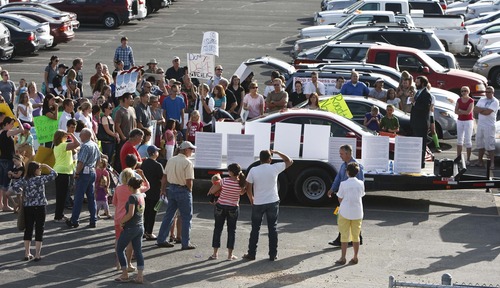This is an archived article that was published on sltrib.com in 2013, and information in the article may be outdated. It is provided only for personal research purposes and may not be reprinted.
The U.S. Interior Department warns that the proposed West Davis Corridor freeway will irreparably harm Great Salt Lake wetlands that are important to migratory birds and is urging state officials to consider instead an alternative that critics proposed to upgrade existing roads and mass transit instead.
"A new 4-lane freeway adjacent to the [Great Salt Lake] shore lands would have significant, irreparable impacts to the wildlife populations that rely on those habitats, would substantially degrade the value of that habitat, and would permanently alter the composition of the wildlife community in the area," federal officials wrote.
That objection is contained in a 15-page letter from Interior Department Regional Environmental Officer Robert F. Stewart about the Utah Department of Transportation's preferred solution for the freeway, which would essentially be a northwestern extension of the Legacy Parkway.
Legacy finally was constructed after a bitter four-year legal battle was settled in 2005 in a negotiated deal with environmental groups who said the original highway plan took shortcuts and caused damage to wetlands and wildlife. The resulting parkway has a reduced speed limit, special sound-muffling pavement, a ban on trucks and extensive areas of preserved wetlands, open space and a trail system.
—
Interior objections • The federal letter objecting to the proposed extension was dated Aug. 14, but critics of the project publicly released a copy on Wednesday. The public comment period on that proposed freeway ends Friday.
Stewart wrote that Interior especially dislikes UDOT's preferred alternative to begin the freeway at Glover Lane instead of farther north at Shepard Lane. Residents in those areas have been battling as homes and businesses are threatened depending on which option is used — and UDOT says fewer buildings would be impacted at Glover Lane.
But Stewart wrote, "The Glover Lane option would be significantly more damaging to GSL shore land wetland and wildlife habitats than the Shepard Lane option."
He explained that while the Shepard Lane option "would directly impact more wetlands, these wetlands and the wildlife habitat they provide are generally already more fragmented, surrounded by more development, and of lesser wildlife value than those of" the Glover Lane option.
The letter also says the Interior Department worries that the freeway would hurt wildlife no matter what alternative is chosen.
"All build alternatives would cause significant, permanent impacts to the wetland and wildlife resources associated with the GSL ecosystem," which the letter said are nationally and internationally important.
—
Wildlife • The Interior Department said also its greatest concern with UDOT's draft environmental impact statement is that it looked at several indirect impacts the project could have on migratory birds — such as water degradation, noise and light and air pollution — without taking into consideration their combined effect.
The letter says UDOT "discounts any overall negative impact on wildlife communities by addressing each factor only individually, describing its effects, how they would be mitigated, and concluding its impacts are insignificant. However, the literature is clear that there are a variety of causal factors that can act synergistically to cause wildlife to avoid roadways and adjacent habitats."
Stewart also urged more consideration of a "shared solution," which some critics proposed late in the process as a way to avoid the new freeway by instead improving existing roads and mass transit to handle area transportation needs. Randy Jefferies, UDOT project director, has said it already studied such proposals among early alternatives, but found the freeway best handles future needs.
Nevertheless, Stewart wrote, "We encourage UDOT to fully vet this alternative… Should this Shared Solution alternative be viable and meet the project purpose and need, it would broaden the range of alternatives and could provide an alternative with fewer impacts to wetland and wildlife resources. We support further development of this alternative."
Steve Erickson, spokesman for the Shared Solution Coalition of conservation groups and opponents of the freeway, which obtained and released the letter, praised the stands by the Interior Department.
"We are pleased that the DOI recognizes, as we do, that the impacts of this project on birds and wildlife and the Great Salt Lake ecosystem are unacceptable," he said.
Erickson added, "We also assert that this project is bad for Davis County residents and an unnecessary waste of Utah taxpayers' money. The DEIS [draft environmental impact statement] is fatally flawed in many respects, and it's time UDOT recognize that it must go back to the drawing board and examine better options for the future for Davis County."





